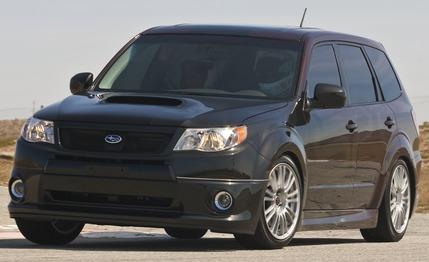 First Drive Review
First Drive Review

Here at Car and Driver, there are many among us who harbor fetishes for the unexpected, the ironic, and of course, the stupidly fast. It’s all the better, of course, if a vehicle combines all three qualities. Not surprisingly, most of us love fearsome cargo carriers like the Mercedes-Benz E63 AMG wagon, the silly Jeep Grand Cherokee SRT8, and the dearly departed Dodge Magnum SRT8. Basically, count us in for anything that has no business being fast but is anyway.
And so we were all over Subaru’s invitation to Willow Springs racetrack near Lancaster, California, to chuck a few laps in one of last year’s SEMA specials: the Forester XTI concept, which is basically a Forester crossover with WRX STI running gear. Since the car isn’t street-legal—and there aren’t enough people like us who could prompt Subaru to actually build something like this for real—this probably will be our only chance to drive it and to see if Subaru can transform the innocuous Forester’s package into something as beguiling as the STI.
Hot for Forester
Before we even turned the key, we were on board. Having grown quite a bit for 2009, the standard Forester has a more-SUV-like profile than ever, but in XTI form—slammed and wearing the STI’s optional silver 18-inch wheels and a bitchin’ black-to-brown paint job—the Forester suddenly looks hot, like that nerdy chick in high school who one day swapped mom jeans for hot pants.
When Subaru claims the Forester XTI “combines the versatility of the Forester 2.5XT with the all-out street performance of the rally-bred Impreza WRX STI,” it means just that. The automaker’s Subaru Performance Tuning team literally combined the two cars as an experiment “to see how many STI parts would fit,” according to SPT representative Adam Woodhull.
SPT started by taking one Forester and one STI, stripping each to the metal, and adding STI pieces to the Forester bit by bit. Since the two cars share a platform, the engine, the six-speed manual transmission, and the STI drivetrain weren’t too difficult to swap over. The cat-back stainless-steel exhaust system had to be massaged in place and fitted with sexy tip extensions (they stick out too far to be legal), but most parts were sourced from SPT and not fabricated. The new exhaust system freed up another 10 hp and 10 lb-ft of torque compared with the stock STI, according to Subaru, so the XTI is good for 315 hp and 300 lb-ft. The only other area of customization involved the new Forester’s unequal-length control-arm rear suspension, which required some minor fittings.
SPT then stuck the STI’s dash and center console into the Forester, as well as the STI’s Alcantara-covered Recaro sport seats. The XTI’s front clip and mesh grille are out of the Subaru of America accessories catalog, and the side and rear addenda are available from Japan’s version of same. The paint job, on the other hand—a four-coat process that required three metallic colors, including the SPT script on the sides—isn’t available anywhere but your local body shop. And they probably couldn’t do it as well.
Easy to Forget the Forester?
Facing the STI’s dashboard, you could easily forget you’re in a Forester, except for the huge glass sunroof overhead. However, the STI seats seem mounted lower and the dashboard seems higher than in the stock Forester, which is particularly noticeable when attempting to lower the steering wheel; it doesn’t reach quite low enough to feel ergonomically natural. Here, it seems, is where the inch or two difference in waistline between the two cars becomes clear. Otherwise, the STI and Forester parts sync in perfect harmony.
Ditto on the track. With the extra grunt underhood, Subaru estimates that the XTI can hit 60 mph in five or fewer seconds, although we weren’t allowed to use test equipment to verify the claim. What we did find as we hustled through the tricky corners of the Streets of Willow course is that the WRX STI beneath the skin was, for the most part, present and accounted for. With the chassis and drive settings in their most aggressive positions—the SI-Drive system in Sport Sharp and the Driver Controlled Center Differential (DCCD) set for maximum rear torque bias—the XTI felt as if it could more or less keep pace with the stock WRX STIs that the company brought along for comparison. The steering had that same light quality that we’ve noted before. The turbo rush is still, uh, prodigious . The installed short-throw shift kit should have upped the overt sportiness factor, but it wasn’t altogether unfriendly. And even after dozens of laps of cooking, the STI-sourced brakes slowed the XTI—estimated to be somewhere between 3600 and 3700 pounds, about 200 more than an STI—with authority. It was, indeed, all sorts of delicious, ironic fun.
Don’t Take This Car Too Seriously
Now, Subaru encourages us not to take this car too seriously, as there’s virtually no chance that it will be built, although a right-hand-drive, manual-transmission STI version of the last-gen Forester was available in Japan. Can a Forester owner build an XTI? “If you raid the parts bin, you could get pretty close,” said Woodhull. How much would it cost? He declined to speculate, but “buying an STI driveline wouldn’t be an inexpensive endeavor.” (We once built our own demon-tweaked Forester, so we know.) Certainly, the effort wouldn’t be cheaper than buying something like a Grand Cherokee SRT8, which is much more powerful and more fun yet. We still like the idea of a hooligan Forester, though, and only wish there were more people like us.